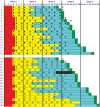Radial ESWT combined with a specific rehabilitation program (rESWT+RP) is more effective than sham rESWT+RP for acute hamstring muscle complex injury type 3b: a randomized, controlled trial
- PMID: 40891881
- PMCID: PMC12403062
- DOI: 10.1093/bmb/ldaf009
Radial ESWT combined with a specific rehabilitation program (rESWT+RP) is more effective than sham rESWT+RP for acute hamstring muscle complex injury type 3b: a randomized, controlled trial
Abstract
Introduction: Acute type 3b injuries of the hamstring muscle complex (HMC) are prevalent in sports, often lead to prolonged recovery, and demonstrate a high recurrence. Conservative rehabilitation is standard, and adjunct therapies such as radial extracorporeal shock wave therapy (rESWT) may offer additional benefits.
Sources of data: This randomized controlled trial, with blinding of patients and assessors, included 36 semi-professional athletes with ultrasound-confirmed acute type 3b HMC injuries. Participants received either real or sham rESWT in combination with an 8-week structured rehabilitation program. The primary outcome was time to return to sport; secondary outcomes included post-treatment muscle strength, patient satisfaction, and re-injury rate.
Areas of agreement: Progressive rehabilitation is effective for muscle injuries. rESWT is a safe, non-invasive modality with high therapeutic potential in musculoskeletal conditions.
Areas of controversy: Questions remain regarding the ideal rESWT protocol for acute muscle injuries, including optimal dosing, frequency, and timing relative to injury onset.
Growing points: The addition of rESWT resulted in a statistically significant reduction in return-to-sport time [25.4 ± 3.5 (mean ± SD) days with rESWT vs 28.3 ± 4.5 days with sham rESWT; P = .037]. In elite and semi-professional athletes, even modest reductions in downtime can carry meaningful performance and economic benefits. Furthermore, only the rESWT group avoided strength deficits in the previously injured leg, suggesting improved functional recovery.
Areas timely for developing research: Future studies should explore the comparative effectiveness of individualized versus standardized rESWT protocols and investigate its broader applicability across sports disciplines and levels of play.
Keywords: ESWT; RCT; extracorporeal shock wave therapy; hamstring; rESWT; radial extracorporeal shock wave therapy; randomized controlled trial; rehabilitation; structural muscle injury.
© The Author(s) 2025. Published by Oxford University Press.
Conflict of interest statement
CS served until 12/2017 and serves since 07/2024 as consultant for Electro Medical Systems (Nyon, Switzerland), the inventor, manufacturer and distributor of the rESWT device Swiss DolorClast that was used in this study. However, Electro Medical Systems did not have any role in data collection and analysis, interpretation of the data, decision to publish and writing the manuscript. The other authors declare no conflict of interest.
Figures





Similar articles
-
Is radial extracorporeal shock wave therapy combined with a specific rehabilitation program (rESWT + RP) more effective than sham-rESWT + RP for acute hamstring muscle complex injury type 3b in athletes? Study protocol for a prospective, randomized, double-blind, sham-controlled single centre trial.J Orthop Surg Res. 2019 Jul 23;14(1):234. doi: 10.1186/s13018-019-1283-x. J Orthop Surg Res. 2019. PMID: 31337441 Free PMC article. Clinical Trial.
-
Comparative Effectiveness of Ultrasound-Guided Corticosteroid Injection and Radial Extracorporeal Shock Wave Therapy for Plantar Fasciitis: A Double-Blind Randomized Controlled Trial.Indian J Orthop. 2025 Jun 10;59(8):1227-1240. doi: 10.1007/s43465-025-01422-5. eCollection 2025 Aug. Indian J Orthop. 2025. PMID: 40852560
-
Prescription of Controlled Substances: Benefits and Risks.2025 Jul 6. In: StatPearls [Internet]. Treasure Island (FL): StatPearls Publishing; 2025 Jan–. 2025 Jul 6. In: StatPearls [Internet]. Treasure Island (FL): StatPearls Publishing; 2025 Jan–. PMID: 30726003 Free Books & Documents.
-
Determinants of Return to Play After the Nonoperative Management of Hamstring Injuries in Athletes: A Systematic Review.Am J Sports Med. 2016 Aug;44(8):2166-72. doi: 10.1177/0363546515617472. Epub 2015 Dec 15. Am J Sports Med. 2016. PMID: 26672025
-
Rehabilitation for hamstring injuries.Cochrane Database Syst Rev. 2012 Dec 12;12(12):CD004575. doi: 10.1002/14651858.CD004575.pub3. Cochrane Database Syst Rev. 2012. PMID: 23235611 Free PMC article.
References
-
- Petersen J, Thorborg K, Nielsen MB. et al. Acute hamstring injuries in Danish elite football: A 12-month prospective registration study among 374 players. Scand J Med Sci Sports. 2010;20:588–92. - PubMed
-
- Müller-Wohlfahrt HW, Ueblacker P, Haensel L. et al. (eds). In: Muscle Injuries in Sports, 1st edn. Stuttgart: Thieme, 2013, 10.1055/b-002-89587 - DOI
Publication types
MeSH terms
Grants and funding
LinkOut - more resources
Full Text Sources
Medical
Research Materials

